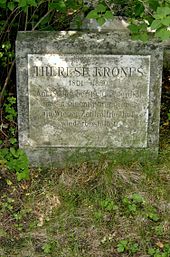Therese Krones

Therese Krones (born October 7, 1801 in Freudenthal , Austrian Silesia , † December 28, 1830 in Vienna ) was an Austrian actress and singer ( soprano ).
Life
Therese Krones was the daughter of the actor Franz Josef Krones (1766–1839) and his wife Anna Theresia Walter (* 1770). The actor Josef Krones was her brother.
At the age of five, Krones was already on stage with her brother with her father. She played on various stages in Pressburg , Laibach , Agram , Graz and Ödenburg . It was discovered by Ferdinand Raimund in Ödenburg .
In 1821 she took up an engagement at the Leopoldstadt Theater . She made her debut with the play The funny tragedy Evakathel and Prince Schnudi or the Siege of Ypsilon by Philipp Hafner . In the next few years she played at the side of Ferdinand Raimund , Friedrich Josef Korntheuer and Ignaz Schuster in works of the Old Vienna Volkstheater .
Krones had the big breakthrough to success in 1824 as Rosamunde in the comedy Lindane or the fairy of the hair bag cutter or the slipper maker in the fairy kingdom by Adolf Bäuerle . Just two years later, in 1826, she celebrated her greatest success as a youth in the fairy tale game Das Mädchen aus der Feenwelt or Der Bauer als Millionär by Ferdinand Raimund.

Moritz von Schwind drew Krones in the trouser role as a youth , and Joseph Kriehuber , the portraitist of the Vienna Society, made a lithograph based on this picture. This representation was u. a. used by the Demel confectionery as a template for a statue made of icing.
Krones' career and soaring society was also characterized by a very wasteful life. This was suddenly about to end when the Polish aristocrat Severin von Jaroszynski , Therese Krones' lover, was exposed as an impostor and robbery and was executed in 1827 at the “New Vienna Gallows” near the spinner on the cross .
Krones disappeared from social life in Vienna and wanted to go to the monastery. Ferdinand Raimund managed to get her back to the theater after several months of pleading. On September 6, 1827, she could be admired again in the title role of Julerl, the cleaner .
In 1828 she played Nettchen in Sylphide, the sea lady ; a magical farce that she had written herself.
In 1830 she left the Leopoldstadt Theater with Ferdinand Raimund and moved to the Theater an der Wien .
Therese Krones died on December 28, 1830 after a brief serious illness at the age of 29 in Vienna. She was buried at the Sankt Marxer Friedhof , where she was exhumed again in the 20th century and buried at the Vienna Central Cemetery (group 32 A, number 45 A) in an honorary grave of the City of Vienna . A small cenotaph at the Sankt Marxer Friedhof reminds of the original burial place.
In 1930 the Kronesgasse in Vienna- Döbling (19th district) was named after her. On April 1, 2003, a public green space in the 2nd district on Jägerzeile near Nestroyplatz was named after her in the municipal council committee for culture , the Therese-Krones-Park .
Works
- The Brandy Burner and the Mist Spirit (1829)
- Cleopatra (1830)
- Sylphide, das See-Fräulein (1828) - full text online .
literature
- Constantin von Wurzbach : Krones, Therese . In: Biographisches Lexikon des Kaiserthums Oesterreich . 13th part. Kaiserlich-Königliche Hof- und Staatsdruckerei, Vienna 1865, pp. 258–262 ( digitized version ).
- Joseph Kürschner : Krones, Therese . In: Allgemeine Deutsche Biographie (ADB). Volume 17, Duncker & Humblot, Leipzig 1883, pp. 190 f.
- Gustav Haas: The Therese Krones soubrette. In: Die Moderne Welt , year 1922, issue 5 (October), year IV, p. 13 ff. (Online at ANNO ). .
- Emil Pirchan : Therese Krones, the theater queen of old Vienna . Wallishauser, Vienna 1942.
- Edith Futter: The most important actresses of the Leopoldstadt Theater from 1800 to 1830. Therese Krones, Katharina Ennöckl, Johanna Huber, Louise Gleich-Raimund and Josefa Sartory - their position and their significance in the old Viennese Volkstheater . Dissertation. University of Vienna, Vienna 1965.
- Edith Futter: Krones Therese. In: Austrian Biographical Lexicon 1815–1950 (ÖBL). Volume 4, Verlag der Österreichischen Akademie der Wissenschaften, Vienna 1969, p. 293 f. (Direct links on p. 293 , p. 294 ).
- Wilhelm Deutschmann (Ed.): Therese Krones on the 150th anniversary of her death. November 6, 1980 to January 11, 1981 . Special exhibition of the Historical Museum of the City of Vienna, Volume 68, ZDB -ID 881004-7 . Self-published by the Museums of the City of Vienna, Vienna 1980.
- Ingrid Nohl-Badenhausen: Krones, Therese. In: New German Biography (NDB). Volume 13, Duncker & Humblot, Berlin 1982, ISBN 3-428-00194-X , pp. 87 f. ( Digitized version ).
Web links
- Therese Krones at Operissimo on the basis of the Great Singer Lexicon
- Entry on Therese Krones in the Austria Forum (in the AEIOU Austria Lexicon )
- Therese Krones. In: FemBio. Women's biography research (with references and citations).
- Entry in the online lexicon of the Wiener Zeitung ( memento from March 11, 2007 in the Internet Archive )
Individual evidence
- ↑ Hedwig Abraham (Red.): Therese Krones . In: viennatouristguide.at , accessed on February 7, 2013.
| personal data | |
|---|---|
| SURNAME | Krones, Therese |
| BRIEF DESCRIPTION | Austrian actress and singer (soprano) |
| DATE OF BIRTH | October 7, 1801 |
| PLACE OF BIRTH | Freudenthal , Austrian Silesia |
| DATE OF DEATH | December 28, 1830 |
| Place of death | Vienna |

